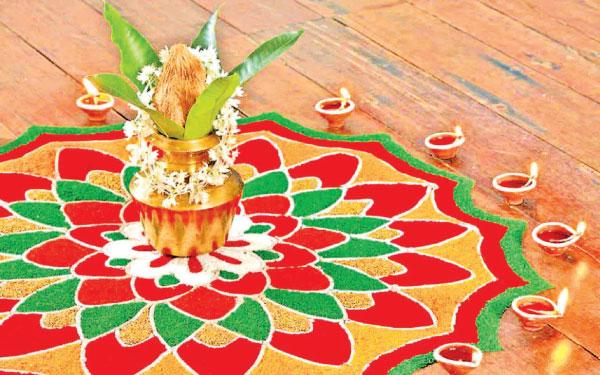
In the chill of January Hindus celebrate the festival of Thai Pongal.
It is considered a harvest festival and is celebrated on the first day in the month of Thai in the Tamil calendar, January 14.
It is celebrated as a harvest festival by the farming community and is meant to honour the Sun God, the Earth and cattle and thank them fot their assistance in producing a bountiful harvest.
Others celebrate it as a thanksgiving offering to the farming community for the production of food. 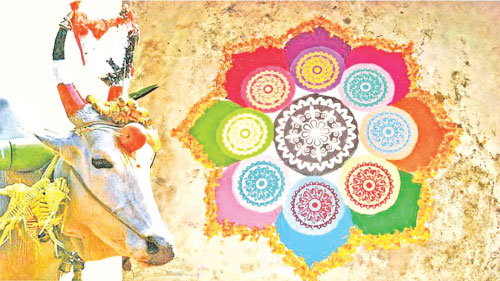
Before the festival, homes are cleaned, white washed and new clothes are sewn or bought.
Thai Pongal Day
On Thai Pongal day families wake up even before dawn and get ready to celebrate Thai Pongal. They bathe, dress in new clothes and assemble the area where the traditional Pongal will be cooked. This would be the front garden or a courtyard or an open terrace.
A flat pitch is made and the area is decorated with kolam designs. These are beautiful and intricate designs drawn with rice flour.
Rice flour is used so that insects will feed on it and bless the household. The pitch is made so that it direct sunlight falls on it. A firewood hearth is built using bricks.
Homes are also decorated with fresh banana leaves, garlands of mango leaves or Mavillai Thoranam.
Pongal rice
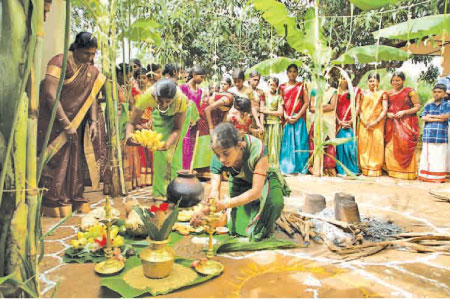 Pongal literally means ‘boiling over’ . The Pongal rice is made with red or white raw rice, ghee, jaggery, green gram, cashew and raisins. Chakkarai or brown cane sugar and katkandu (sugar candy) is also used. A few pods of cardamom may also be used.
Pongal literally means ‘boiling over’ . The Pongal rice is made with red or white raw rice, ghee, jaggery, green gram, cashew and raisins. Chakkarai or brown cane sugar and katkandu (sugar candy) is also used. A few pods of cardamom may also be used.
The boiling over of the Pongal rice heralds prosperity and as this happens people joyfully shout Pongalo Pongal. This means overflowing.
The cooking of the Pongal rice begins with the placing of a clay pot filled with water on the makeshift hearth.
A senior family member does the cooking assisted by others.
When the water is boiling three handfuls of rice will be first put into the pot.
When the Pongal rice is cooked the first helping is placed on a banana leaf and after praying it is offered to the Sun God.
Then, the families partake of the meal. Bananas and mangoes form a part of this meal.
Later, the food is shared among relatives, friends and neighbours.
Even though each family makes their own Pongal rice the sharing of this rice is an important feature of Thai Pongal.
People also engage in religious activities on this day and visit friends and relatives.
Four-day festival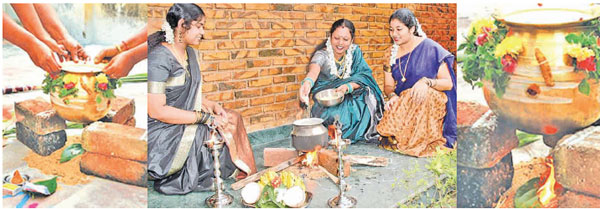
Thai Pongal is a four-day festival. The first day Bhogi is celebrated on the last day of the month of Margachi and God Indra is honoured on this day.
The second day is Surya Pongal or perum Pongal. People worship the Sun God on this day. The day after the Thai Pongal Day or the third day is the Mattu Pongal day. On this day, the cattle are honoured.
They are bathed and their horns are polished. They are decorated with vermillion, garlands and brass trappings. They are well fed too. The fourth day is Kaanum Pongal. Generally, on this day families gather on river banks and enjoy a sumptuous meal called kootanchoru.
Traditional dances such as Kummi and Kolarram may be performed on this day.
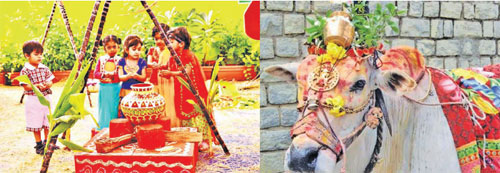 Legends
Legends
Many legends are associated with Thai Pongal. A popular legend assoc iated with Bhogi Pongal , the day on which the Rain God Indra is worshipped is connected to Lord Krishna.
On this day, the Rain God Indra is worshipped and moreover Lord Krishna lifted the Govandham mountain on his little finger to shelter his people and prevent them from being washed away.
Another legend is about Lord Shiva.
According to this legend, Lord Shiva had asked his bull, Nandi to visit earth and tell the people to have an oil bath daily and to eat once a month.
However, once he got to earth Nandi got the message all mixed up and told the people to eat daily and have an oil bath once a month. Lord Shiva was displeased.
He told Nandi that as people would now need more food Nandi would have to wait on Earth and help them plough the fields.
